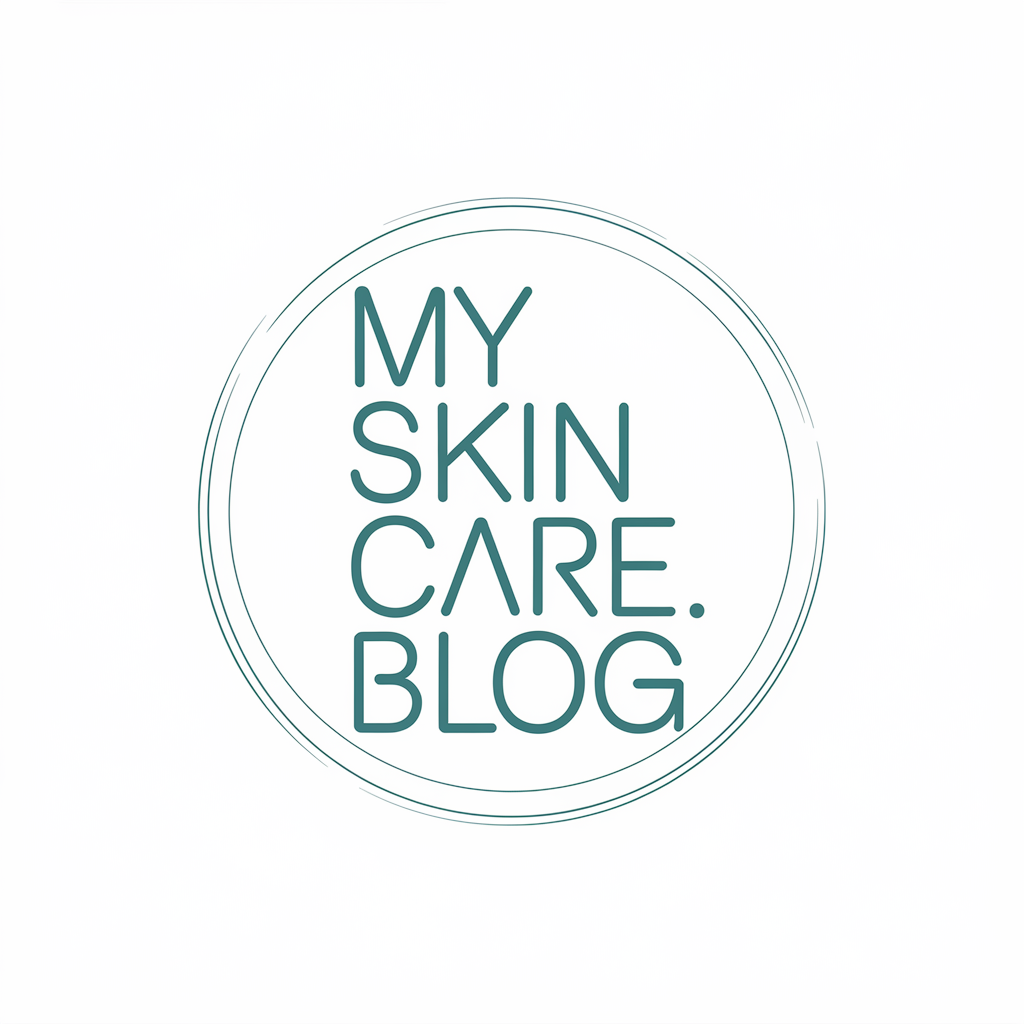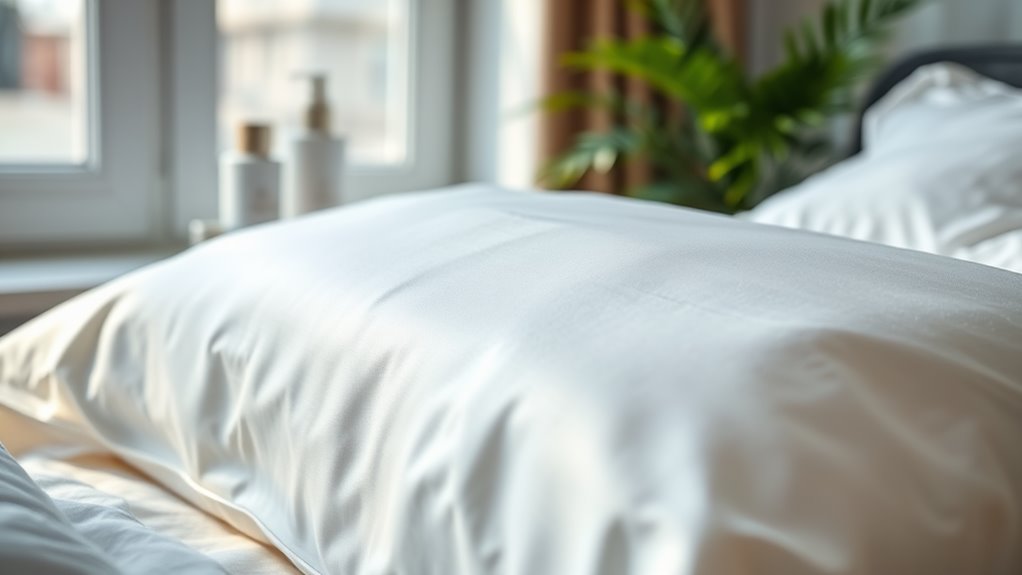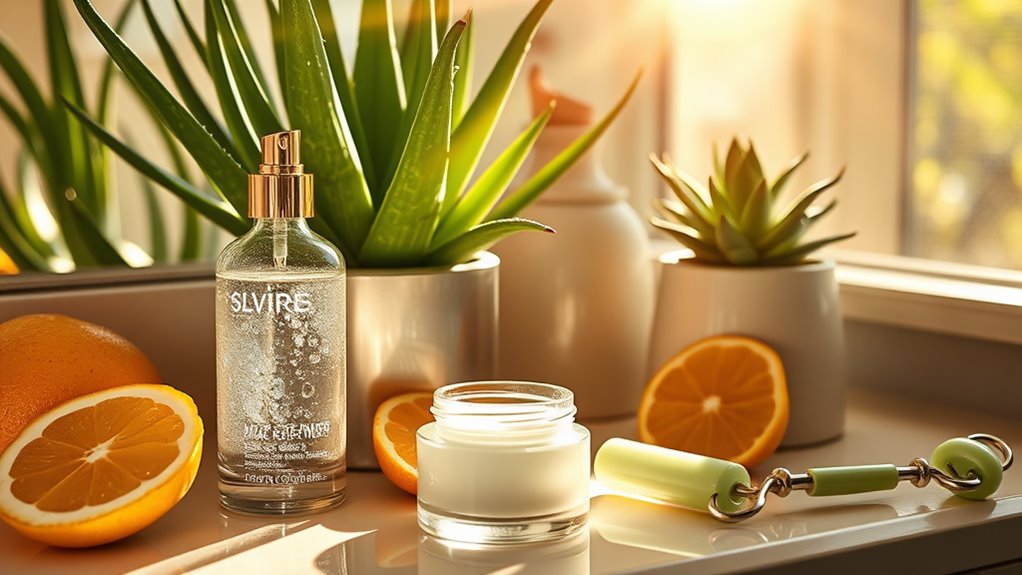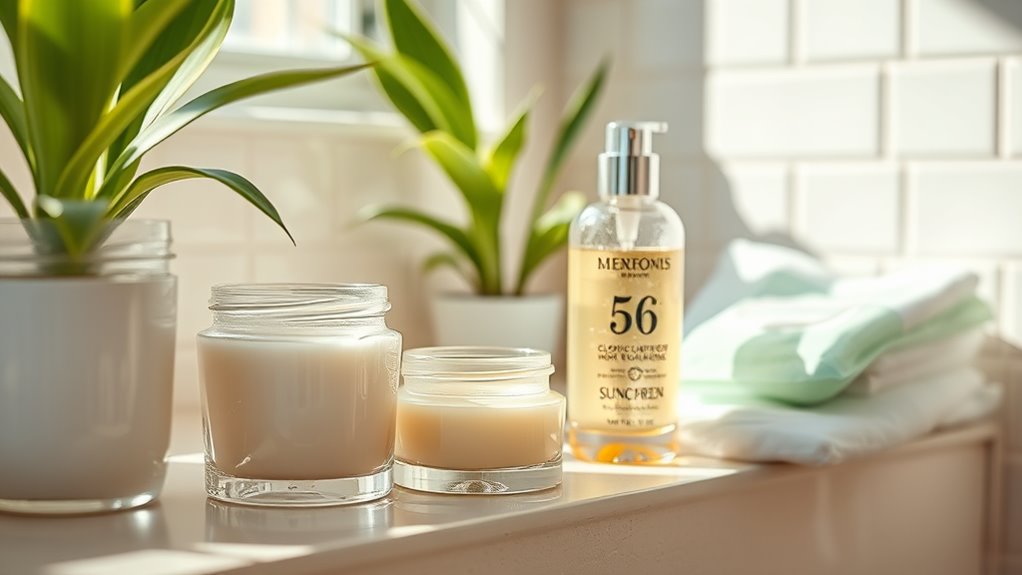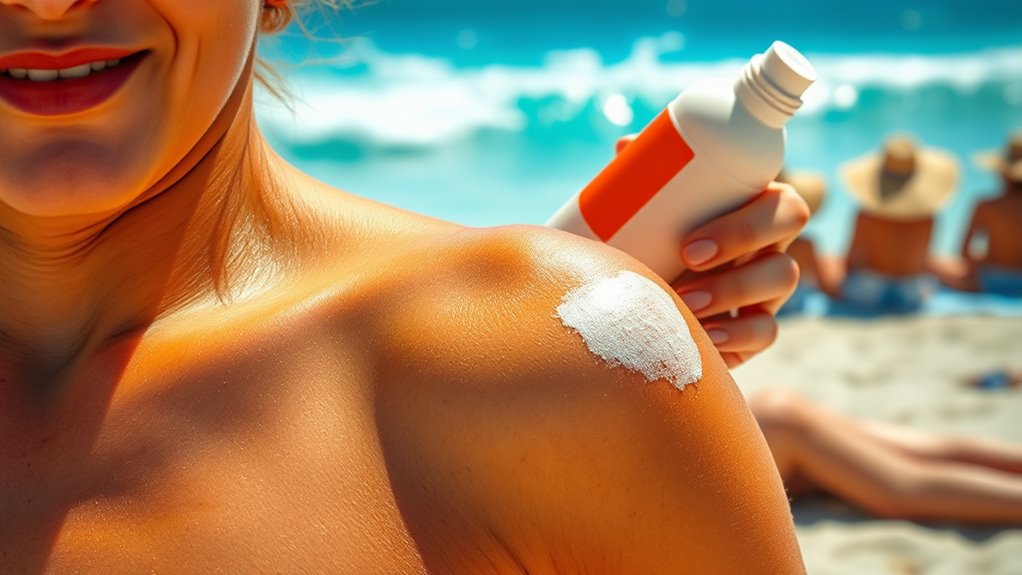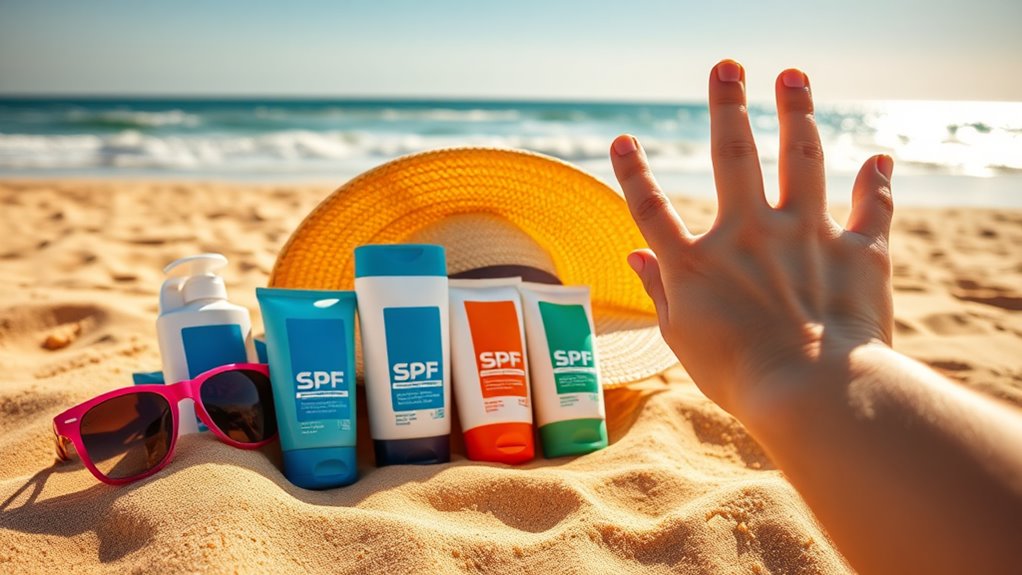Can Your Pillowcase Affect Your Skin. You’ll Be Shocked
Have you ever considered that your pillowcase might be impacting your skin more than you realize? It’s not just about comfort; the material and cleanliness of your pillowcase can play a significant role in your skin’s health. Oils, bacteria, and dead skin cells can accumulate, leading to irritation and breakouts. As you continue to use the same pillowcase, the effects can become more pronounced. What hidden dangers could be lurking on your bed?
Key Takeaways
- Dirty pillowcases harbor bacteria and dead skin cells, leading to breakouts and skin irritation.
- Friction from certain fabrics can cause micro-tears, contributing to premature aging and wrinkles.
- The choice of pillowcase material affects moisture retention, with silk and satin better for hydration than cotton.
- Allergens and irritants in unwashed pillowcases can trigger skin reactions and exacerbate allergies.
- Clean, breathable fabrics promote healthier skin and improve overall complexion during sleep.
The Role of Pillowcases in Skin Health
Have you ever considered how your pillowcase impacts your skin?
The fabric you rest your face against daily plays a significant role in your skin health.
A dirty pillowcase can harbor bacteria, oils, and dead skin cells, leading to breakouts and irritation.
Meanwhile, the friction between your skin and the pillowcase can cause micro-tears, contributing to premature aging.
You mightn’t realize that the choice of material and how often you change your pillowcase can greatly influence your skin’s overall condition.
Prioritizing clean, breathable fabrics can enhance your skin’s appearance and promote a healthier complexion while you sleep. Additionally, poor sleep patterns can exacerbate skin issues, making it even more crucial to maintain a clean sleeping environment.
Material Matters: Cotton vs. Silk vs. Satin
When choosing a pillowcase, the material you select plays a vital role in your skin’s health.
Cotton offers breathability but can absorb moisture, while silk and satin provide a smoother surface that reduces friction.
Understanding these differences can help you make an informed choice that benefits your skin.
Breathability of Fabrics
How does the breathability of your pillowcase fabric influence your skin health?
The right fabric can greatly impact your skin’s condition while you sleep.
Here’s how different materials compare:
- Cotton: Highly breathable, allowing air circulation that helps regulate temperature.
- Silk: Offers moderate breathability, reducing friction but can trap heat if not ventilated properly.
- Satin: Generally less breathable than cotton, which might cause overheating during sleep.
- Linen: Exceptionally breathable, wicking moisture away, and promoting a cooler sleep environment.
Choosing the right pillowcase fabric is essential for maintaining healthy skin and ensuring a comfortable night’s sleep.
Moisture Retention Properties
The moisture retention properties of your pillowcase can greatly impact your skin’s hydration levels throughout the night.
Cotton, while breathable, absorbs moisture, potentially drawing hydration away from your skin.
Silk, on the other hand, maintains a more balanced humidity level, allowing your skin to retain moisture effectively.
Satin offers similar benefits, providing a smooth surface that doesn’t absorb as much moisture as cotton.
Choosing silk or satin can help keep your skin hydrated, reducing the risk of dryness and irritation.
Understanding these differences can help you make informed choices that directly benefit your skin’s health and appearance.
Friction and Skin Health
Ever wondered how the material of your pillowcase influences skin health?
The friction generated while you sleep can greatly impact your skin, especially over time.
Here’s how different materials stack up:
- Cotton: Highly absorbent but can create friction, leading to irritation and wrinkles.
- Silk: Low friction surface reduces skin tugging, promotes hydration, and minimizes acne.
- Satin: Similar to silk, it offers a smooth feel, reducing friction while being budget-friendly.
- Microfiber: Soft and gentle, it provides some friction reduction but lacks moisture-wicking properties.
Choosing the right pillowcase material matters for healthier skin.
The Impact of Cleanliness on Your Skin
Keeping your pillowcase clean is vital for maintaining healthy skin. Bacteria, oil, and dirt accumulate on your pillowcase over time, all of which can lead to breakouts and irritation. The type of fabric you choose can also influence how these elements interact with your skin, making cleanliness an essential factor in your skincare routine. Additionally, proper cleansing techniques can further help to minimize the transfer of impurities from your pillowcase to your face.
Bacteria and Skin Health
How much attention do you pay to the cleanliness of your pillowcase?
Neglecting it can lead to bacterial growth that harms your skin.
Bacteria thrive in warm, damp environments, and your pillowcase is no exception.
Here are four reasons to prioritize its cleanliness:
- Acne Development: Bacteria can clog pores, leading to breakouts.
- Skin Inflammation: Dirty pillowcases can trigger allergic reactions, causing redness and irritation.
- Exacerbated Conditions: Existing skin issues, like eczema, can worsen.
- Transfer of Oils: Bacteria can mix with natural oils, promoting further skin problems.
Keep your pillowcase clean for healthier skin!
Oil and Dirt Accumulation
Have you ever considered the impact of oil and dirt accumulation on your skin?
Each night, your pillowcase collects natural oils, sweat, and environmental pollutants from your hair and face.
Over time, this buildup can clog pores, leading to breakouts and dullness.
When you rest your head on a dirty pillowcase, you’re transferring these impurities back onto your skin, exacerbating issues like acne and irritation.
Regularly washing your pillowcase helps eliminate this accumulation, promoting a clearer, healthier complexion.
Prioritizing cleanliness not only benefits your pillow but also plays a vital role in maintaining your skin’s overall health and appearance.
Fabric Material Effects
The fabric material of your pillowcase can greatly influence your skin’s health.
Different materials have unique properties that can either promote or hinder skin wellness.
To maintain ideal skin condition, consider the following:
- Cotton: Breathable and absorbent, but can trap oils if not washed regularly.
- Silk: Reduces friction and moisture loss, potentially preventing wrinkles and irritation.
- Satin: Similar benefits to silk; it’s smooth and helps maintain skin hydration.
- Synthetic Fabrics: Often trap heat and moisture, leading to breakouts.
Choosing the right pillowcase material and keeping it clean can greatly impact your skin’s appearance and health.
How Pillowcases Can Contribute to Acne
Ever wondered if your pillowcase could be a hidden culprit behind your acne?
The fabric you rest your face on can harbor bacteria, oil, and dead skin cells, which can clog your pores and lead to breakouts.
If you’re using the same pillowcase for too long without washing it, you’re basically pressing your skin against a breeding ground for acne-causing irritants.
Additionally, certain materials can exacerbate this issue, trapping moisture and promoting bacterial growth. Regularly changing and washing your pillowcases can greatly reduce your risk of acne, providing a simple yet effective way to protect your skin while you sleep. Furthermore, everyday habits such as not changing your pillowcase often enough can significantly contribute to skin issues.
The Connection Between Pillowcases and Skin Hydration
How much thought do you give to the material of your pillowcase when it comes to skin hydration?
The right pillowcase can substantially impact your skin’s moisture retention.
Here are four key factors to evaluate:
-
Fabric Type: Natural fibers like silk or satin can help maintain skin moisture better than cotton.
-
Breathability: Choose breathable materials to prevent overheating, which can lead to moisture loss.
-
Wicking Properties: Some fabrics wick away moisture, which may dehydrate your skin.
-
Laundry Products: Detergents can leave residues that affect hydration; opt for gentle, hypoallergenic options.
Choosing wisely matters!
Allergens and Irritants: What Lurks on Your Pillowcase
What potential allergens and irritants might be hiding on your pillowcase?
You could be unknowingly exposing your skin to dust mites, pet dander, and mold spores.
These microscopic invaders thrive in fabric, increasing the risk of irritation and allergies.
Additionally, residual laundry detergents and fabric softeners can cause skin reactions, especially if they contain harsh chemicals or fragrances.
Even your own oils and dead skin cells accumulate over time, creating a breeding ground for bacteria.
By understanding these hidden threats, you can take steps to protect your skin and improve your overall health. Identifying harmful ingredients in your skincare routine can further enhance your skin’s resilience.
Awareness is key to a better night’s sleep.
Tips for Choosing the Right Pillowcase for Your Skin
When selecting the right pillowcase for your skin, you should consider the material, weave, and care instructions to minimize irritation and enhance your skincare routine.
Here are four key tips to help you choose:
- Material: Opt for silk or satin; these fabrics reduce friction, preventing wrinkles and irritation.
- Weave: A tighter weave can help repel allergens and bacteria, supporting clearer skin.
- Care Instructions: Choose machine-washable options for easy cleaning and maintenance.
- Hypoallergenic Properties: Look for pillowcases labeled hypoallergenic to reduce potential skin reactions.
Additionally, using the right pillowcase can complement your skincare routine by promoting youthful-looking skin, as it helps to maintain moisture and prevent dehydration.
Making the right choice can greatly impact your skin’s health.
